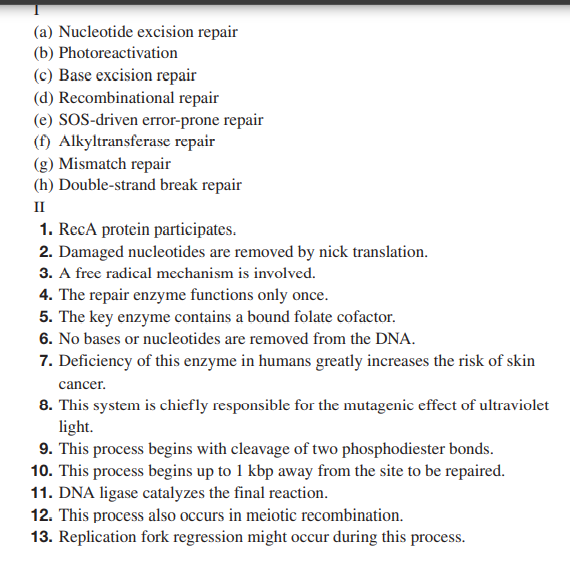(a) Nucleotide excision repair (b) Photoreactivation (c) Base excision repair (d) Recombinational repair (e) SOS-driven error-prone repair (f) Alkyltransferase repair (g) Mismatch repair (h) Double-strand break repair II 1. RecA protein participates. 2. Damaged nucleotides are removed by nick translation. 3. A free radical mechanism is involved. 4. The repair enzyme functions only once. 5. The key enzyme contains a bound folate cofactor. 6. No bases or nucleotides are removed from the DNA. 7. Deficiency of this enzyme in humans greatly increases the risk of skin cancer. 8. This system is chiefly responsible for the mutagenic effect of ultraviolet light. 9. This process begins with cleavage of two phosphodiester bonds. 10. This process begins up to 1 kbp away from the site to be repaired. 11. DNA ligase catalyzes the final reaction. 12. This process also occurs in meiotic recombination. 13. Replication fork regression might occur during this process.
(a) Nucleotide excision repair (b) Photoreactivation (c) Base excision repair (d) Recombinational repair (e) SOS-driven error-prone repair (f) Alkyltransferase repair (g) Mismatch repair (h) Double-strand break repair II 1. RecA protein participates. 2. Damaged nucleotides are removed by nick translation. 3. A free radical mechanism is involved. 4. The repair enzyme functions only once. 5. The key enzyme contains a bound folate cofactor. 6. No bases or nucleotides are removed from the DNA. 7. Deficiency of this enzyme in humans greatly increases the risk of skin cancer. 8. This system is chiefly responsible for the mutagenic effect of ultraviolet light. 9. This process begins with cleavage of two phosphodiester bonds. 10. This process begins up to 1 kbp away from the site to be repaired. 11. DNA ligase catalyzes the final reaction. 12. This process also occurs in meiotic recombination. 13. Replication fork regression might occur during this process.
Biology: The Dynamic Science (MindTap Course List)
4th Edition
ISBN:9781305389892
Author:Peter J. Russell, Paul E. Hertz, Beverly McMillan
Publisher:Peter J. Russell, Paul E. Hertz, Beverly McMillan
Chapter19: Genomes And Proteomes
Section: Chapter Questions
Problem 12TYK
Related questions
Question
For each DNA repair process in column I, list all characteristics from column II that correctly describe that process.

Transcribed Image Text:(a) Nucleotide excision repair
(b) Photoreactivation
(c) Base excision repair
(d) Recombinational repair
(e) SOS-driven error-prone repair
(f) Alkyltransferase repair
(g) Mismatch repair
(h) Double-strand break repair
II
1. RecA protein participates.
2. Damaged nucleotides are removed by nick translation.
3. A free radical mechanism is involved.
4. The repair enzyme functions only once.
5. The key enzyme contains a bound folate cofactor.
6. No bases or nucleotides are removed from the DNA.
7. Deficiency of this enzyme in humans greatly increases the risk of skin
cancer.
8. This system is chiefly responsible for the mutagenic effect of ultraviolet
light.
9. This process begins with cleavage of two phosphodiester bonds.
10. This process begins up to 1 kbp away from the site to be repaired.
11. DNA ligase catalyzes the final reaction.
12. This process also occurs in meiotic recombination.
13. Replication fork regression might occur during this process.
Expert Solution
This question has been solved!
Explore an expertly crafted, step-by-step solution for a thorough understanding of key concepts.
This is a popular solution!
Trending now
This is a popular solution!
Step by step
Solved in 2 steps

Knowledge Booster
Learn more about
Need a deep-dive on the concept behind this application? Look no further. Learn more about this topic, biology and related others by exploring similar questions and additional content below.Recommended textbooks for you

Biology: The Dynamic Science (MindTap Course List)
Biology
ISBN:
9781305389892
Author:
Peter J. Russell, Paul E. Hertz, Beverly McMillan
Publisher:
Cengage Learning

Biology: The Dynamic Science (MindTap Course List)
Biology
ISBN:
9781305389892
Author:
Peter J. Russell, Paul E. Hertz, Beverly McMillan
Publisher:
Cengage Learning